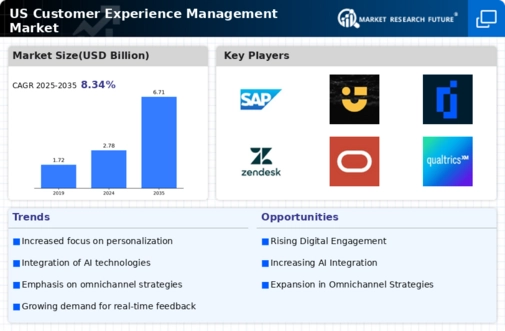Rise of Digital Transformation
The ongoing digital transformation across various sectors is a pivotal driver for the customer experience-management market. Organizations are increasingly adopting digital tools to enhance customer interactions and streamline processes. In 2025, it is estimated that over 70% of companies in the US will prioritize digital initiatives, which could lead to a substantial increase in investments in customer experience technologies. This shift not only improves operational efficiency but also fosters a more personalized customer journey. As businesses leverage data analytics and automation, the customer experience-management market is likely to witness significant growth, with projections indicating a market value exceeding $20 billion by 2026. The integration of digital solutions is essential for companies aiming to remain competitive in an evolving marketplace.
Demand for Enhanced Data Privacy
As data privacy concerns continue to rise, the customer experience-management market is experiencing a shift towards enhanced data protection measures. Consumers are increasingly aware of their rights regarding personal information, prompting businesses to adopt more transparent practices. In 2025, it is projected that nearly 80% of US consumers will prioritize companies that demonstrate a commitment to data privacy. This trend compels organizations to invest in customer experience solutions that not only comply with regulations but also build trust with their clientele. Consequently, the customer experience-management market is likely to see a surge in demand for technologies that ensure data security while delivering personalized experiences. This focus on privacy is essential for maintaining customer relationships in an era where trust is paramount.
Influence of Social Media Engagement
Social media platforms have become integral to customer engagement, significantly impacting the customer experience-management market. Businesses are increasingly utilizing these platforms to interact with customers, gather feedback, and promote their services. In 2025, it is estimated that over 60% of consumers will prefer brands that actively engage with them on social media. This trend encourages companies to develop strategies that leverage social media insights to enhance customer experiences. By analyzing customer interactions and preferences on these platforms, organizations can tailor their offerings and improve satisfaction levels. The customer experience-management market is thus likely to benefit from the growing need for tools that facilitate effective social media engagement, ultimately leading to stronger customer relationships.
Growing Importance of Customer Loyalty
Customer loyalty has emerged as a critical focus for businesses, driving the customer experience-management market. Companies recognize that retaining existing customers is often more cost-effective than acquiring new ones. In 2025, studies suggest that a mere 5% increase in customer retention can lead to profit increases of 25% to 95%. This realization prompts organizations to invest in customer experience strategies that foster loyalty, such as personalized communication and rewards programs. As a result, the customer experience-management market is expected to expand, with businesses allocating more resources to understand and enhance customer satisfaction. The emphasis on loyalty not only boosts revenue but also strengthens brand reputation, making it a vital component of modern business strategy.
Shift Towards Proactive Customer Service
The shift towards proactive customer service is reshaping the landscape of the customer experience-management market. Businesses are increasingly recognizing the value of anticipating customer needs rather than merely reacting to issues as they arise. In 2025, it is projected that companies employing proactive service strategies will see a 30% increase in customer satisfaction ratings. This proactive approach involves utilizing data analytics to predict customer behavior and preferences, allowing organizations to offer tailored solutions before problems occur. As a result, the customer experience-management market is expected to grow as businesses invest in technologies that enable proactive engagement. This shift not only enhances customer satisfaction but also reduces operational costs associated with reactive service models.

















Leave a Comment